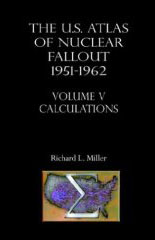|
U.S. Atlas of Nuclear Fallout 1951-1962 Calculations

ISBN: 1-881043-19-3
The U.S. Atlas of Nuclear Fallout 1951-1962 Volume
5 : Calculations was written only to answer one question: where
did the numbers come from? Broadly, the various radioisotope values were
calculated from ratios found in a set of documents known as the Hicks Tables--a
group of papers written by radiochemist Harry G. Hicks of Lawrence Livermore
Laboratory. Dr. Hicks measured the amounts of each and every important radioisotope
produced by the various nuclear detonations at the Nevada Test Site---and
then published the data. As a result, we know the general spectrum of radioisotopes
found in each nuclear test. Not surprisingly, each nuclear test seemed to
be unique. Sedan, for example, produced massive amounts of the radioisotope
beryllium-7, yet most of the other tests produced none at all.
By knowing how much radioiodine (I-131)
was deposited on a given county--and then knowing from the Hicks
Tables the ratio of radioiodine to the other radioisotopes---it
was possible to estimate how much of a specific radioisotope
(for example, cobalt-60) might have been deposited with the
radioiodine (I-131).
The Calculations volume is a 700-page blueprint
showing how the calculations for the other books were done.
You can find the U.S. Atlas of Nuclear Fallout
by visiting these booksellers.
| 